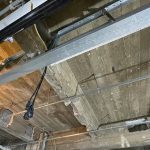A High-Quality build needs to be supervised to get it right. Poor construction supervision means serious QC issues – plus endless headaches, meetings, & painful fixes for everyone involved.
On a 25,000sf commercial project now in a close-out stage post move-in, I’ve had a major problem for several weeks with quality control. It was entirely predictable, as early as March 2022.
The project began November ’21 and originally had an expected mid-April move-in. This was later pushed to the end of April ’22. Over time this transformed to a late May ’22 actual Substantial Completion – and now in mid-late July, serious quality control issues are finally being resolved.
The path to get here was laborious, complicated, and also entirely avoidable. It has also taken no less than twenty meetings since April to get things right between the two vendors that didn’t take the initiative to supervise the completion of their work – a furniture vendor, and the Construction Manager.
The issue? No one was supervising the completion of work – for weeks on end!
The solution to our quality control problems became a combination of supervision, by someone who knew how to pay attention to details and supervise the installers, to delivery what the client was ultimately looking and paying for.

Above: …can you see the chip in the glass?
Quick Background
In terms of the Triangle of Project Management (our next video, to be released soon), our project was a combination of a high quality scope plus with a strict, limited construction budget, and thus a flexible schedule.
From the very beginning the client was highly concerned about keeping the costs of work down, and was flexible with the move-in date as long as all teams completed their work to a high standard. The client already occupied one floor – the new upper floor was simply an office extension doubling their overall square footage, following exactly the same design principles as the original project.
In principle this should have made the design process far easier to coordinate – with an existing design to copy/match. In reality, the team did not take the initiative to detail the project with the original project details and challenges in mind. Our team was the same as the original build-out, but it was clear midway into the project that the construction team was moving too slowly, and many key details were left unresolved in the design and shop drawings.
In February, supply chain delays shifted our original early April move-in date to the end of April. By the time late March rolled around, as Owner/Manager I became seriously concerned with the progress on site, as did the Client. All of us raised concerns about progress over at least three weeks – and in fact, the Client even held back payment just in case. But most of all, I stressed to the team the goals of the project – the move in date was flexible, but the work had to be done to the highest standard.
This was communicated multiple times to all vendor teams, and was especially stressed to the Furniture Vendors and to the CM. Only one of our two Furniture vendors listened, and their work was entirely supervised through installation by their lead Project Manager – and finished on time. Meanwhile, another Furniture Vendor and the Construction Manager spent weeks doing work, and then re-doing the same work – always unsupervised. This easily occurred 7 times in some cases, like the Stair.
Stair Construction Quality Issues
On this project the Client is most disappointed with the quality of the stair construction.
The new connecting stair between the new and old floors was easily the most complex and expensive part of this project, requiring extensive coordination with the structural engineers and steel subcontractor, plus slab removals. For various reasons (also entirely avoidable) the stair fell behind schedule for several weeks past the anticipated completion of the remainder of the new floor.
To make a long story short:
- The contractor delayed starting the stair late into the job; even though the construction schedule and move in date was extended by 6 weeks for the entire project.
- The stair was also the longest lead component on the entire project, involving the glass subs, stone subs, and a millworker in charge of fabricating white lacquer panels for finish. Shop drawings for all of these things were coordinated far too late.
- Once the Client actually started to move in (delayed 6 weeks), the Contractor felt pressurized to finish.
- Thus, quality control and direction began to suffer, as the Contractor tried to rush the stair opening.
- Key details for reveals were not coordinated properly between the Architect, Contractor and Subcontractor, during the Shop Drawing and Review Phase. Also, they were too focused on punch listing the remainder of the floor, facing its own issues.
- The Contractor Superintendent was not someone that possessed the eye for fine detail, although he was very good at getting things done up to that point.
As we allowed the stair area continue to continue past the main project move in, temporary partitions were erected around the stair until it was completed.
Once the stair finally opened for team use, it was clear many things were wrong:
- Lacquer panels were not aligned, and the lacquer was applied unevenly.
- In parts of the stair reveals were filled in with lacquer, in other parts they were not.
- The fills were also applied unevenly.
- Panels were disjointed and not aligned.
- Glass panels weren’t aligned, and gaskets were missing.
- There were numerous finishes that looked chipped and unfinished.
See if you can spot the issues:




We’ve had no less than six meetings over the past five weeks, to review stair construction and quality, and the finger pointing began in earnest.
The contractor assured everything would be taken care of according to the Architect’s recommendations. The Architect on his part didn’t give clear directions or recommendations – or drawings – instead communicated instructions verbally to the Owner of the Construction Management company (whom then passed it verbally down the chain). After several early attempts – all unsuccessful, both the Architect and Contractor tried to get out of the work by convincing the client that everything looked fine to them. And yet the client, walking the stair on a daily basis, noticed that quality had *further declined* and then refused to make any further payments to either company.
Lack Of Supervision or Eye For Detail
In one of our final two meetings, it seems like everything once again went haywire, with yet another meeting between the Architect, Contractor, and Client, to review the work that needed to be performed – and this time, the Construction team got caught in the act.
A work plan was set to repair the stair finishes from Friday thru Sunday. Images were distributed on Thursday morning, with exactly what to do. The Architect also sent an email, with his notes, directives and comments on these images. The Owner of the CM firm also emailed us and communicated everything to the team.
As Owner/Manager, I requested:
- that a firm work plan be issued before work begins on Friday, and
- that the CM team share images of the completed work
We then had a call on Friday afternoon before the weekend – to be sure everyone understood the work plan and would follow through.
Only the Vice President of the CM firm attended the call – and not our project’s Project Manager or Superintendent.
When asked “who is there to make sure that everything gets done right?” the Vice President replied that the Superintendent would there. Note that the Super-intendent was to this point the person who was in charge of “supervising” this work to begin with, and to this date despite 5 attempts, we had regressed instead of improved. To let him also be in charge of making sure the work is finished properly, when it wasn’t done well to begin with, was highly suspect.
Sometimes you have to take people on their word – and then later on, you can say that you told them so and hold them accountable.
In this situation, the contractor embarrassed themselves:
- Not trying to understand the problems the Client was describing , nor taking detailed notes and truly understanding how to fix it.
- Applying the wrong people to correct the problem, and repeatedly doing so. As the phrase goes, Insanity Is Doing the Same Thing Over Again, and Expecting Different Results
Balls Drop on Attempt #6
After that call, we never hear back from the Contractor regarding their work plan; and later that evening, I even sent a reminder email, to no avail.
As the Owner/Manager, it was my role to make sure things were getting done right. I decided to go to the site myself on Saturday morning and see what was going on – we were assured all work would be going to plan.
At 10:30am Saturday, I walked in to find only two laborers on the site attempting to spot repair the stair, and it was apparent almost none of the Architects or Client comments were picked up.
What was shocking was that the laborers had zero idea about all of the different conditions needing to be fixed, but also couldn’t be blamed – it simply wasn’t communicated to them, and the details got lost in the chain.
But most shocking – the superintendent was away & not on site, despite us being reassured he would be there. I tried calling him and he didn’t respond; nor did I get a response to the voicemail I left.
I called our CM Project Manager too, to no avail – he also did not return my call.
We left the site and told the workers to continue – but it was obvious that everyone had just wasted everyone’s time.
The Contractor Made Critical Errors:
- Not communicating the plan of attack for the work.
- Not having capable supervision for the work, and being there to begin with.
- Also not emailing or updating us as requested – and once we checked, we discovered that nothing was being done as described by the Contractor’s team.
Change in Supervision & Leadership
After this event we read the Riot Act on Monday, and the Client refused payments to the CM. This finally spurned the CM to take a different plan of attack. Our team requested a Senior PM from the CMs outside team (not involved in this project), come and inspect the work – it was someone worked with many times successfully on other projects, and we knew had the experience for detail on other high finish projects.
As if almost on cue, his assessment was completely different – NOT to do spot touch-ups as advised by the Architect and the Superintendent, but instead it was to remove the panels over the weekend, have they re-sprayed with lacquer onsite to achieve an even finish with proper reveals, and then reinstall everything on site.
In the end, the work required not spot touch ups, which were also done unsupervised, but a full re-do of the entire stair panel install. And the PM recommended instead that the stair be disassembled, be re-sprayed on site for a clean finish, and then reinstalled correctly – all supervised.
Headaches could have been avoided in the first place, by:
- Following proper procedures to ensure work was done correctly at the original time of install, rather than rushing to project completion.
- Following the correct procedures to fabricate and install the panels.
- Understanding the client’s goals, rather than focusing on simply completing work. In terms of Project Management, the primary points on the Triangle were Scope and Budget, the former which necessitated attention to detail.
- Having the A Team on the job in the first place.
This past weekend, the stair install was completed correctly with the panels resprayed, and all deficiencies corrected.
The Critical Lesson – Quality Control Requires Supervision
The critical lesson – both foreseen on this project, and also what it took to finish the job – was proper supervision with an eye for detail.
For projects that required high finishes and impeccable Quality Control, there are no exceptions. To date, I’ve honestly never seen a quality job completed unsupervised. Only dedicated professionals whom know what they’re doing, and have the Eye For Detail, can seem to pull this off. This goes doubly so for Contractors as well – as the main entity building the job, its their role to make sure they deliver according to the client’s wishes.
At the end of the day, it is poor form for any professional company, to sign off on and direct work, without personally supervising the work they are responsible for. Not only did the CM and the Architect waste everyone’s time, they also wasted their own, cost themselves financial headaches, reputation loss and possible legal action – all for not listened to the client’s reasonable requests for quality control.
Quick Note:
The one kind of project you can get away without quality control management, is the one where the Client’s priority is a low budget and a fast schedule.
Usually this is to Get To Revenue, Fast!
As an example, consider a fast food or fast chain restaurant – where the building is standardized, the finishes and architecture are finalized for the branding, and the Owner’s goal of the project is to get revenue up and running, as fast as possible. For such projects, scope & quality is of low priority, as the Client’s real goal is to get to revenue, with the least amount of time and money invested.
On the flip side, scope matters A LOT when the goal of the project is not getting to revenue quickly, or when there is no revenue involved at all, only expenses. In those situation, the client cares about getting a high quality product for a good price.







 Table Of Contents
Table Of Contents

Leave a Reply